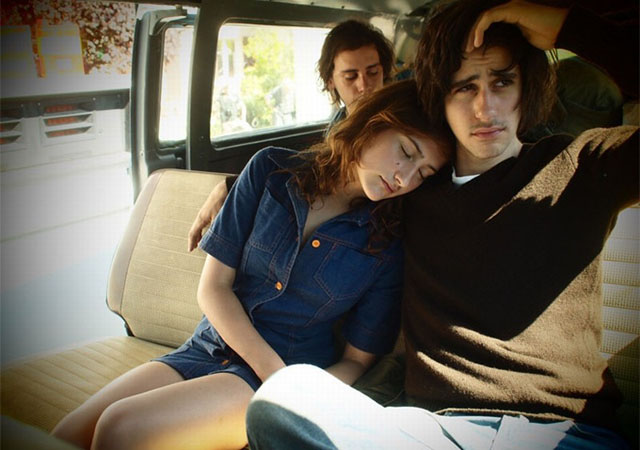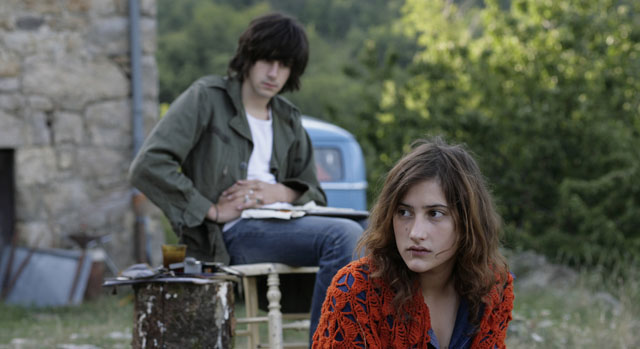“In his darkly poetic 1994 feature, Cold Water, Olivier Assayas revisited his early-70s adolescence in a town near Paris via a youth named Gilles and his troubled girlfriend Christine,” begins David Rooney in the Hollywood Reporter. “The French writer-director returns to that time and place, with leads again named Gilles and Christine, in the exquisite, semi-autobiographical Something in the Air (Après mai). While the earlier drama was notable for its absence of politics, the new film is virtually bursting with revolutionary ferment, albeit viewed with reflective detachment. That shouldn’t suggest a distancing approach. This is a beautifully crafted work and an acute evocation of its period both in look and attitude, and it’s no less deeply absorbing for being somewhat muted in tone.”
Oliver Lyttelton sets it up at the Playlist: “On the outskirts of Paris in 1971, the spirit of May 1968 still lingers in the air, not least for high-school student and aspiring artist Gilles (Clément Métayer) and his friends Alain (Félix Armand), Jean-Pierre (Hugo Conzelmann) and Christine (Lola Créton, who starred in this year’s Goodbye First Love, directed by Assayas’ partner Mia Hansen-Love), who spend their time (at least when Gilles isn’t hanging out with his girlfriend, Carole Combes’s Laure) volunteering for leftist papers, protesting and generally planning the revolution. But when Laure breaks up with Gilles to leave for London, and a protest prank goes horribly wrong, Gilles and Christine (who’ve just become a couple themselves, and not coincidentally share their names with the protagonists of Cold Water) head to Italy, Gilles gradually falling out of love with painting and in love with filmmaking, while Alain, who joins them, falls for an artistic American dancer, Leslie (India Salvor Menuez).”
“‘Shouldn’t revolutionary cinema employ a revolutionary syntax?’ someone asks at one point, following a screening of agitprop films.” Variety‘s Justin Chang: “It’s not the only moment here in which Assayas seems to be winking at viewers, who may recall the writer-director’s career has veered between cerebral high-art freakouts like Demonlover and deceptively bougie-looking dramas like Summer Hours…. Decidedly not revolutionary cinema, Something in the Air instead quietly demystifies its subject. The tone of the piece is wryly affectionate but never indulgent; the experiences depicted feel emotionally true and lived-in without ever catching the viewer up in a rush of intoxication or excitement. Eschewing the handheld restlessness of Assayas’ recent films, d.p. Eric Gautier’s luminous, sun-dappled compositions remain as steady as the editing by Luc Barnier and Mathilde Van de Moortel, which compounds the film’s slightly muted feel with regular fade-ins and fade-outs.”
“Assayas’s film will put many in mind of Bertolucci’s The Dreamers,” suggests Guy Lodge at In Contention, “compared to which it’s both springier and less insipid. Still, if the two films’ young semi-heroes are similarly glassy and irritating in their idealism—a debit to which Assayas seems more cheerfully willing to admit than most—that could say as much about the revisionist nature of contemporary liberalism as anything else. Assayas might well believe that revolutionary cinema should be revolutionary in its construction: his restless, throbbing Carlos, a study in 1970s anarchism that stands as the stylistic and political negative to this more fetchingly wispy panorama, may fall short of that imposing ‘r’ word, but it’s the more inspired, agitated film. The more pertinent question he seems to be asking is whether the figures at the heart of his story, a version of himself among them, merit revolutionary cinema at all.”
“The drug culture has its share,” notes Dan Fainaru in Screen, “the multitude of opinions vented by the so-called ‘free press’ is here too, so do the films that come out at the time (clips out of Bo Widerberg’s Joe Hill and Jorge Sanjines’s The Night of San Juan), the music of the period (at one point, Johnny Flynn sings a Phil Ochs ballad from the ’60’s), the moods and the cultural winds blowing from east and west alike. Briefly, this is a real time-machine trip into the past and to Assayas’s credit, rarely has a movie done such an intelligent and thorough job of it.”
Tommaso Tocci, writing at Press Play, agrees that “the winning card up Assayas’s sleeve is the uncanny ability to let these references float softly around the characters, never bringing them to the foreground. You only see them as reflections in their eyes, parts of a confused sentimental education without boundaries.”
Boyd van Hoeij: “If anything, Something in the Air attempts to be a naturalistic look at the early 1970s, free of any kind of wink-wink irony—except for the natural kind that is provided by hindsight.” Also in Cineuropa, Assayas tells Domenico La Porta: “I don’t know if the film is sad. There is the presence of love, tenderness, and nature, but it’s true that I have slightly stepped away from works that describe adolescence as a wildly fun period of partying and flirting. This is not how I remember it. I remember a certain melancholy and political seriousness. Leftism was quite sad and violent, and this was reflected among the youth upholding the changes of May 1968, who asked themselves how they could join this movement for change to be heard and serve a purpose.”
Something in the Air has screened in Competition at Venice and will screen this weekend in the Masters program at Toronto, where Assayas will be giving a Master Class.
Update: Writing for Cinema Scope, Andrew Tracy argues that “just as L’heure d’été (2008) gave the appearance of a polite French art-house export while subtly evolving into something more complex and irresolvable—a cunningly modest form of Situationist détournement, one could say—Après mai grows larger, and closer, in the rearview. As the film enters its final movements, with Gilles working on a film set in London and haunting avant-garde screenings in his off hours, Assayas refuses his young vicar a conclusion (or even a definite direction) to his sentimental education. Even as his path becomes clearer, Gilles remains bound to a yearning extraneous to his ‘natural’ progression and self-realization. It was this inchoate longing that drove both May and the long post-May, and as Assayas elegantly attests in his final sequence (the film’s one rupture from realism), it is a longing both impossible to encapsulate in fleeting material reality and impossible not to see as such, beckoning just outside of one’s grasp.”
Update, 9/5: “Free of nostalgia and not overly critical in hindsight, it captures the immediacy of youth in hugely endearing fashion,” finds Time Out London‘s Dave Calhoun.
Updates, 9/6: Dennis Lim introduces an interview with Assayas for the New York Times: “Unfolding as a series of romantic entanglements, political awakenings and artistic discoveries, the film touches on themes familiar from any number of movies about the end of the ’60s and the end of adolescence. But it also strikes a balance—fond but clear-eyed, fetishistic in its attention to period detail yet devoid of sentimentality.”
At the House Next Door, Jamie Dunn, too, praises the film’s “canny balance of nostalgia with hindsight.”
Update, 9/9: The AV Club‘s Scott Tobias finds that “for all the strengths that come with autobiography, like the specificity of Assayas’s memories, Something in the Air has some of the weaknesses, too, like a shapelessness that creeps in and starts to paralyze the film as it goes along.”
Updates, 9/16: David Bordwell notes that “the movie is a tribute to analog reproduction–mimeograph machines, LPs and turntables, and cinema in its different guises, from exploitation films to agitprop and experimental lyrics.” In the film collective, Gilles “encounters the arguments that made me smile in nostalgia: Shouldn’t revolutionary content have a revolutionary form? But how shall we reach the working class if our films are opaque? Assayas, who grew in this period and was repelled by the Maoist dogmatism of Cahiers du cinéma and Cinéthique, evokes these debates to remind us that the counterculture was about art and political change at one and the same time. Something in the Air chronicles a few years when imagination mattered.”
Bordwell also attended Assayas’s Masterclass and notes that the filmmaker “was refreshingly detailed about his working methods. He writes only one draft of his screenplay, partly because he wants to protect the ‘digressive’ aspects of his story. (This tendency is apparent, and enjoyable, in Something in the Air.) Since his films are difficult to classify within standard genres, he needs to cobble together creative financing for each project. But the script becomes obsolete when he casts the film and visits locations. By embodying the characters, the actors create beings ‘more powerful than what I’ve written.'”
Fernando F. Croce in MUBI’s Notebook: “There’s a sprinkling of Godard-speak (a film-within-the-film about Laos peasants is dismissed for its ‘bourgeois syntax’) and an air of Garrel, but in the end Assayas’s vision of the past hews a bit too close to something like, say, Taking Woodstock.”
For Jordan Cronk, writing at the House Next Door, “something about Something in the Air feels oddly disinterested in engaging with the motivations behind the rebellion. Assayas seems more concerned with the characters themselves, and how their lives coincide and speak to the consequences of the revolution.”
IndieWIRE‘s Eric Kohn talks with Assayas “about his decision to take on this personal tale post-Carlos, why the early 70’s stand out in his memories, and what he hopes to do next.”
Venice and Toronto 2012: a guide to the coverage of the coverage. For news and tips throughout the day every day, follow @KeyframeDaily on Twitter and/or the RSS feed. Get Keyframe Daily in your inbox by signing in at fandor.com/daily.





